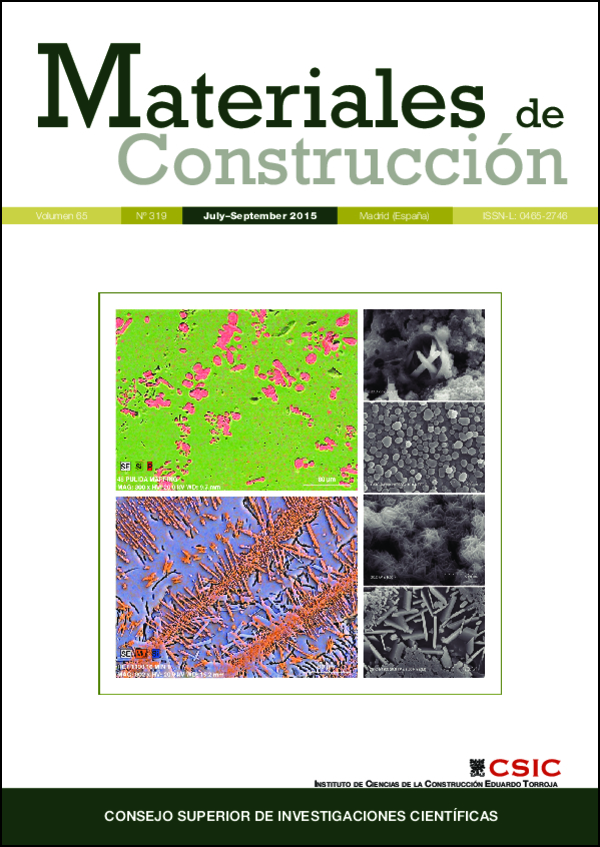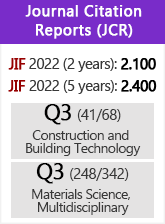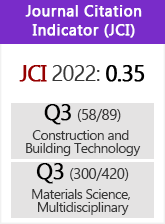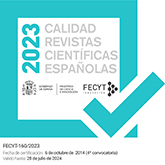Devonian micritic limestones used in the historic production of Prague hydraulic lime (‘pasta di Praga’): characterization of the raw material and experimental laboratory burning
DOI:
https://doi.org/10.3989/mc.2015.06314Keywords:
Limestone, Lime, Bicalcium silicate, Scanning Electron Microscopy (SEM), X-ray Diffraction (XRD)Abstract
The Devonian micritic limestones from the Prague Basin (Barrandian area, Bohemian Massif, Czech Republic), which were the primary raw material used for natural hydraulic lime burned in Prague, exhibit a feebly to eminently hydraulic character. Based on a laboratory experimental study, the burned product is composed of dominant free-lime (CaO) and/or portlandite (Ca(OH)2), larnite-belite (bicalcium silicate 2CaO.SiO2), and quartz (SiO2) - i.e. phases formed due to the decomposition of carbonate and quartz, present in the original limestones. Proportions of the newly formed phases depend on: the composition of the raw material, maximum burning temperature (the highest amount of larnite-belite appearing at a burning temperature of 1200 °C), and the granulometry of the experimental batches (a coarsely-ground batch exhibited a higher amount of larnite-belite compared to the finely-ground one). The presence of minor phyllosilicates in the raw material contributed to the formation of gehlenite, brownmillerite, wollastonite, calcium aluminate, and/or spurrite.
Downloads
References
1. Hughes, D.C.; Sugden, D.B.; Jaglin, D.; Mucha, D. (2008) Calcination of Roman cement: A pilot study using cement-stones from Whitby. Constr. Build. Mat. 22, 1446–1455. http://dx.doi.org/10.1016/j.conbuildmat.2007.04.003
2. Juenger, M.C.G.; Winnefeld, F.; Provis, J.L.; Ideker, J.H. (2011) Advances in alternative cementitious binders. Cem. Concr. Res. 41, 1232–1243. http://dx.doi.org/10.1016/j.cemconres.2010.11.012
3. Callebaut, K.; Elsen, J.; Van Balen, K.; Viaene, W. (2001) Nineteenth century hydraulic restoration mortars in the Saint Michael's Church (Leuven, Belgium). Natural hydraulic lime or cement? Cem. Concr. Res. 31, 397–403. http://dx.doi.org/10.1016/S0008-8846(00)00499-3
4. Elert, K.; Rodriguez-Navarro, C.; Sebastian Pardo, E.; Hansen, E.; Cazalla, O. (2002) Lime mortars for the conservation of historic buildings. Stud. Cons. 47, 62–75. http://dx.doi.org/10.1179/sic.2002.47.1.62
5. Van Balen, K.; Papayianni, I.; Van Hees, R.; Binda, L.; Waldum, A. (2005) Introduction to requirements for and functions and properties of repair mortars. Mat. Struct. 38, 781–785. http://dx.doi.org/10.1007/BF02479291
6. Maravelaki-Kalaitzaki, P. (2007) Hydraulic lime mortars with siloxane for waterproofing historic masonry. Cem. Concr. Res. 37, 283–290. http://dx.doi.org/10.1016/j.cemconres.2006.11.007
7. Moropoulou, A.; Polikreti, K. (2009) Principal Component Analysis in monument conservation: Three application examples. J. Cult. Herit. 10, 73–81. http://dx.doi.org/10.1016/j.culher.2008.03.007
8. Bianco, N.; Calia, A.; Denotarpietro, G.; Negro, P. (2013) Laboratory assessment of the performance of new hydraulic mortars for restoration. Procedia Chem. 8, 20–27. http://dx.doi.org/10.1016/j.proche.2013.03.004
9. Gullota, D.; Goidanich, S.; Tedeschi, C.; Nijland, T.G.; Toniolo, L. (2013) Commercial NHL-containing mortars for the preservation of historical architecture. Part 1: Compositional and mechanical characterisation. Constr. Build. Mat. 38, 31–42. http://dx.doi.org/10.1016/j.conbuildmat.2012.08.029
10. Moropoulou, A.; Bakolas, A.; Moundoulas, P.; Aggelakopoulou, E.; Anagnostopoulou, S. (2013) Optimization of compatible restoration mortars for the earthquake protection of Hagia Sophia. J. Cult. Herit. 14, Suppl. e147–e152. http://dx.doi.org/10.1016/j.culher.2013.01.008
11. Hughes, D.C.; Jaglin, D.; Kozłowski, R.; Mucha, D. (2009) Roman cements - Belite cements calcined at low temperature. Cem. Concr. Res. 39, 77–89. http://dx.doi.org/10.1016/j.cemconres.2008.11.010
12. Weber, J.; Gadermayr, N.; Kozłowski, R.; Mucha, D.; Hughes, D.; Jaglin, D.; Schwarz, W. (2007) Microstructure and mineral composition of Roman cements produced at defined calcination conditions. Mater. Character. 58, 1217–1228. http://dx.doi.org/10.1016/j.matchar.2007.04.025
13. Kozłowski, R.; Hughes, D.; Weber, J. (2010) Roman cements: key materials of the built heritage of the 19th century. In: Bos¸tenaru, D.; Prˇikryl, R.; Török, Á. (eds.) Materials, Technologies and Practice in Historic Heritage Structures. Springer, Dordrecht New York. 259–277. http://dx.doi.org/10.1007/978-90-481-2684-2_14
14. Giavarini, C.; Ferretti, A.S.; Santarelli, M.L. (2006) Mechanical characteristics of Roman "opus caementicium". In: Kourkoulis, S.K. (ed.) Fracture and Failure of Natural Building Stones. Springer, Berlin. 107–120. http://dx.doi.org/10.1007/978-1-4020-5077-0_7
15. Prikryl, R.; Novotná, M.; Prˇikrylová, J.; Weishauptová, Z.; Št'astná, A. (2011) Physical and mechanical properties of the repaired sandstone ashlars in the facing masonry of the Charles bridge in Prague (Czech Republic) and analytical study for the causes of its rapid decay. Environ. Earth Sci. 63, 1623–1639. http://dx.doi.org/10.1007/s12665-010-0819-5
16. Sabbioni, C.; Zappia, G.; Riontino, C.; Blanco-Varela, M.T.; Aguilera, J.; Puertas, F.; Van Balen, K.; Toumbakari, E.E. (2001) Atmospheric deterioration of ancient and modern hydraulic mortars. Atm. Environ. 35, 539–548. http://dx.doi.org/10.1016/S1352-2310(00)00310-1
17. Oleson, J.P.; Brandon, C.; Cramer, S.M.; Cucitore, R.; Gotti, E.; Hohlfelder, R.L. (2004) The Romacons project: a contribution to the historical and engineering analysis of hydraulic concrete in roman maritime structures. Int. J. Nautic. Archaeol. 33, 199–229. http://dx.doi.org/10.1111/j.1095-9270.2004.00020.x
18. Ingo, G.M.; Fragalà, I.; Bultrini, G.; Caro, T.; Riccucci, C.; Chiozzini, G. (2004) Thermal and microchemical investigation of Phoenician–Punic mortars used for lining cisterns at Tharros (western Sardinia, Italy). Thermochim. Acta 418, 53–60. http://dx.doi.org/10.1016/j.tca.2003.11.053
19. Moropoulou, A.; Bakolas, A.; Anagnostopoulou, S. (2005) Composite materials in ancient structures. Cem. Concr. Comp., 27(2), 295–300. http://dx.doi.org/10.1016/j.cemconcomp.2004.02.018
20. Silva, D.A.; Wenk, H.R.; Monteiro, P.J.M. (2005) Comparative investigation of mortars from Roman Colosseum and cistern. Thermochim. Acta 438, 35–40. http://dx.doi.org/10.1016/j.tca.2005.03.003
21. Velosa, A.L.; Coroado, J.; Veiga, M.R.; Rocha, F. (2007) Characterization of Roman mortars from Conímbriga with respect to their repair. Mater. Character. 58, 1208–1216. http://dx.doi.org/10.1016/j.matchar.2007.06.017
22. Láník, J.; Cikrt, M. (2001) Two thousand years of the Czech lime and cement industries. Svaz vy´robcu• cementu a vápna Cˇech, Moravy a Slezska, Vyzkumny ústav maltovin Praha spol. s r. o., Praha (In Czech).
23. Chlupác, I. (1988) The Devonian of Czechoslovakia and its stratigraphic significance. In: McMillian, N.J.; Embry, A.F.; Glass, D.J. (eds.) Devonian of the World, Canadian Society for Petroleum Geologists, Memoirs, 14. 481–497.
24. Chlupác, I.; Havlícek, V.; Kríž, J.; Kukal, Z.; Štorch, P. (1998) Palaeozoic of the Barrandian (Cambrian to Devonian). Czech Geological Survey, Prague, 183.
25. Havlícek, V. (1981) Development of a linear sedimentary depression exemplified by the Prague Basin (Ordovician - Middle Devonian, Barrandian, Central Bohemia). Sbor. geol. Ved, rada G, 7–48.
26. Chlupác, I.; Brzobohaty, R.; Kovanda, J.; Stráník, Z. (2002) Geologická minulost Cˇeské republiky. Academia, Prague (in Czech).
27. Melichar, R. (2004) Tectonics of the Prague Synform: a hundred years of scientific discussion. Krystalinikum 30, 167–187.
28. Röhlich, P. (2007) Structure of the Prague Basin: The deformation diversity and its causes (the Czech Republic). Bull. Geosci. 82, 175–182. http://dx.doi.org/10.3140/bull.geosci.2007.02.175
29. Cháb, J. (1993) General problems of the TB (Teplá-Barrandian) Precambrian, Bohemian Massif, the Czech Republic. Vestník CˇGÚ 68, 1–6.
30. Glasmacher, U.A.; Mann, U.; Wagner, G.A. (2002) Thermotectonic evolution of the Barrandian, Czech Republic, as revealed by apatite fission-track analysis. Tectonophysics 359, 381–402. http://dx.doi.org/10.1016/S0040-1951(02)00538-3
31. Kríž, J. (1999) Geological monuments of Prague. Proterozoic and Lower Paleozoic. Czech Geological Survey, Prague, 278. (In Czech with English summary).
32. Chlupác, I.; Kukal, Z. (1986) Reflexion of possible global Devonian events in the Barrandian area. C.S.S.R. Lecture Notes in Earth Sciences 8, 171–179.
33. Dunham, R.J. (1962) Classification of carbonate rocks according to depositional texture. In: Ham, W.E. (ed.) Classification of carbonate rocks. AAPG, Memoir 1, 108–121.
34. Prikryl, R.; Št'astná, A. (2010) Contribution of clayey-calcareous silicite to the mechanical properties of structural mortared rubble masonry of medieval Charles Bridge in Prague (Czech Republic). Eng. Geol. 115, 257–267. http://dx.doi.org/10.1016/j.enggeo.2010.06.009
35. Zeno, F. (1770) Beschreibung des bei Prag von dem Wissehrader Tore gelegenen Kalksteinbruches, mit seinen Seeversteinerungen und anderen Fossilien. N. physik. Belustigun. 2, 362–420.
36. Kirschenbaum, H. (1983) The classical chemical analysis of silicate rocks – the old and the new. Geological Survey Bulletin 1547, United States Government Printing Office, Washington.
37. Rosen, O.M.; Abbyasov, A.A.; Migdisov, A.A.; Yaroshevskii, A.A. (2000) MINLITH–A Program to Calculate the Normative Mineralogy of Sedimentary Rocks: The Reliability of Results Obtained for Deposits of Old Platforms. Geochem. Int. 38, 388–400.
38. Rosen, O.M.; Abbyasov, A.A.; Tipper, J.C. (2004) MINLITH–an experience-based algorithm for estimating the likely mineralogical compositions of sedimentary rocks from bulk chemical analyses. Comp. Geosci. 30, 647–661. http://dx.doi.org/10.1016/j.cageo.2004.03.011
39. Spalding, F.P. (1898) Hydraulic cement. Its properties, testing, and use. 1st ed., John Wiley & Sons, New York. PMid:17738760
40. Eckel, E.C. (1928) Cements, Limes and Plasters: Their Materials, Manufacture, and Properties. 3rd ed., John Wiley & Sons, New York.
41. Folk, R.L. (1962) Spectral subdivision of limestone types. In: Ham W.E. (ed.) Classification of carbonate rocks. AAPG, Memoir 1, 62–84.
42. Konta, J. (1973) Quantitative system of residual rocks, sediments and volcanoclasic deposits. Universita Karlova, Praha. (In Czech).
43. Cowper, A.D. (1927) Lime and Lime Mortars. Building Research Station, HM Stationary Office, London.
44. Mu.ller, Ch.J. (2005) Pozzolanic activity of natural clay minerals with respect to environmental geotechnics. Unpublished manuscript of Ph.D. thesis, Swiss Federal Institute of Technology, Zu.rich.
45. Varas, M.J.; Alvarez de Buergo, M.; Fort, R. (2005) Natural cement as the precursor of Portland cement: Methodology for its identification. Cem. Concr. Res. 35, 2055–2065. http://dx.doi.org/10.1016/j.cemconres.2004.10.045
46. Elsen, J.; Mertens, G.; Van Balen, K. (2011) Raw materials used in ancient mortars from the Cathedral of Notre-Dame in Tournai (Belgium). Eur. J. Mineral. 23, 871–882. http://dx.doi.org/10.1127/0935-1221/2011/0023-2139
47. Bolio-Arceo, H.; Glasser, F.P. (1990) Formation of spurite, Ca5(SiO4)2CO3. Cem. Concr. Res. 20, 301–307. http://dx.doi.org/10.1016/0008-8846(90)90084-B
48. Glasser, F.P. (1973) The formation and thermal stability of spurite, Ca5(SiO4)2CO3. Cem. Concr. Res. 3, 23–28. http://dx.doi.org/10.1016/0008-8846(73)90058-6
Published
How to Cite
Issue
Section
License
Copyright (c) 2015 Consejo Superior de Investigaciones Científicas (CSIC)

This work is licensed under a Creative Commons Attribution 4.0 International License.
© CSIC. Manuscripts published in both the printed and online versions of this Journal are the property of Consejo Superior de Investigaciones Científicas, and quoting this source is a requirement for any partial or full reproduction.All contents of this electronic edition, except where otherwise noted, are distributed under a “Creative Commons Attribution 4.0 International” (CC BY 4.0) License. You may read here the basic information and the legal text of the license. The indication of the CC BY 4.0 License must be expressly stated in this way when necessary.
Self-archiving in repositories, personal webpages or similar, of any version other than the published by the Editor, is not allowed.


















